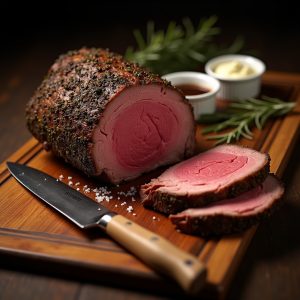
AI generated image
Chef's Tip
For the most accurate cooking time and perfect doneness, invest in a good quality meat thermometer. Insert it into the center of the roast, avoiding bone, and remove the prime rib from the oven when it's 5-10 degrees below your desired final temperature, as it will continue cooking during the resting period.
Instructions
- Remove roast from refrigerator 1 hour before cooking to allow it to come to room temperature.
- Preheat oven to 450°F. Set a roasting rack in a large roasting pan.
- In a small bowl, combine salt, pepper, minced garlic, rosemary, thyme, mustard, and olive oil to form a paste.
- Pat roast dry with paper towels. Rub the herb paste all over the roast, covering all sides.
- Place roast bone-side down on the roasting rack. The bones create a natural roasting rack.
- Roast at 450°F for 20 minutes to develop a crust, then reduce temperature to 325°F.
- Continue roasting for about 15 minutes per pound, or until an instant-read thermometer inserted into the center registers 120°F for rare, 125-130°F for medium-rare, or 135°F for medium.
- Transfer roast to a cutting board and tent loosely with foil. Let rest for 20-30 minutes before carving.
- Meanwhile, make the au jus: Place roasting pan on stove over medium heat. Add wine and scrape up any browned bits from the bottom of the pan.
- Add beef stock and simmer until reduced by half, about 10 minutes. Strain into a serving bowl.
- For horseradish cream: Mix prepared horseradish with sour cream and heavy cream. Season with salt to taste.
- After resting, cut strings and remove bones if desired. Slice meat across the grain to desired thickness.
Plating
Arrange slices of prime rib on a warmed platter with the rarer center pieces toward the middle and the more well-done end pieces around the edges. Serve with small bowls of warm au jus and horseradish cream on the side. Garnish the platter with fresh herb sprigs for a festive presentation. For individual servings, place 1-2 slices on each plate with small ramekins of the accompaniments.
Storage & Reheating
Leftover prime rib can be refrigerated in an airtight container for up to 3 days. To reheat without overcooking, place slices in a covered baking dish with a splash of beef broth, and warm in a 300°F oven just until heated through, about 15-20 minutes. Alternatively, enjoy cold slices in sandwiches. The au jus and horseradish cream can be refrigerated separately for up to 3 days.
About This Recipe
Prime rib has long been a centerpiece for celebratory meals in New England, particularly in historic Boston restaurants. This preparation draws from that tradition with a focus on simple seasonings that enhance the natural flavor of the beef rather than mask it. While maintaining the classic approach of slow roasting over the bones, this recipe incorporates a flavorful herb crust that adds dimension to the meal without detracting from the star ingredient.
